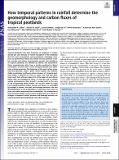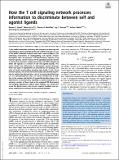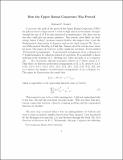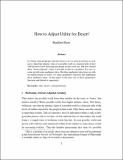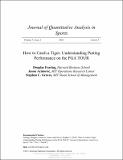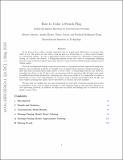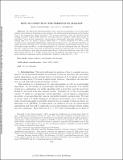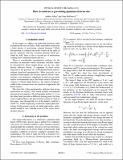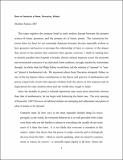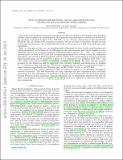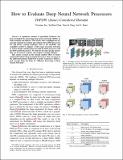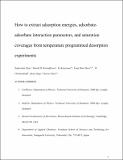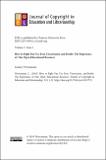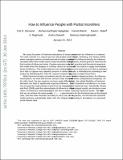Browsing MIT Open Access Articles by Title
Now showing items 21813-21832 of 55765
-
How temporal patterns in rainfall determine the geomorphology and carbon fluxes of tropical peatlands
(National Academy of Sciences (U.S.), 2017-06)Tropical peatlands now emit hundreds of megatons of carbon dioxide per year because of human disruption of the feedbacks that link peat accumulation and groundwater hydrology. However, no quantitative theory has existed ... -
How the news media activate public expression and influence national agendas
(American Association for the Advancement of Science (AAAS), 2017-11)We demonstrate that exposure to the news media causes Americans to take public stands on specific issues, join national policy conversations, and express themselves publicly—all key components of democratic politics—more ... -
How the T cell signaling network processes information to discriminate between self and agonist ligands
(Proceedings of the National Academy of Sciences, 2020)© 2020 National Academy of Sciences. All rights reserved. T cells exhibit remarkable sensitivity and selectivity in detecting and responding to agonist peptides (p) bound to MHC molecules in a sea of self pMHC molecules. ... -
How the Upper Bound Conjecture Was Proved
(Springer-Verlag, 2014-07)We give a short history of how the Upper Bound Conjecture for Spheres was proved. -
How to adjust utility for desert
(Taylor & Francis, 2011-06)It is better when people get what they deserve. So we need an axiology according to which the intrinsic value of a possible world is a function of both how well-off and how deserving the people in that world are. But how ... -
How to Catch a Tiger: Understanding Putting Performance on the PGA TOUR
(Walter de Gruyter, 2011-01)Existing performance metrics utilized by the PGA TOUR have biases towards specific styles of play, which make relative player comparisons challenging. Our goal is to evaluate golfers in a way that eliminates these biases ... -
How to Color a French Flag: Biologically Inspired Algorithms for Scale-Invariant Patterning
(Springer International Publishing, 2020)© 2020, Springer Nature Switzerland AG. In the French flag problem, initially uncolored cells on a grid must differentiate to become blue, white or red. The goal is for the cells to color the grid as a French flag, i.e., ... -
How to Compute in the Presence of Leakage
(Society for Industrial & Applied Mathematics (SIAM), 2015-10)We address the following problem: how to execute any algorithm P, for an unbounded number of executions, in the presence of an adversary who observes partial information on the internal state of the computation during ... -
How to construct a gravitating quantum electron star
(American Physical Society, 2013-09)Motivated by the holographic study of Fermi surfaces, we develop methods to solve Einstein gravity coupled to fermions and gauge fields, with anti–de Sitter boundary conditions and a chemical potential. -
How to Construct a Poem: Descartes, Sidney
(Manchester University Press, 2013)This essay explores the intimate bond in early modern Europe between the premier science of forms, geometry, and the premier art of forms, poetry. The connections between these (at least for us) seemingly disparate ... -
HOW TO DISTINGUISH BETWEEN CLOUDY MINI-NEPTUNES AND WATER/VOLATILE-DOMINATED SUPER-EARTHS
(IOP Publishing, 2013-12)One of the most profound questions about the newly discovered class of low-density super-Earths is whether these exoplanets are predominately H2-dominated mini-Neptunes or volatile-rich worlds with gas envelopes dominated ... -
How to Distribute Computation in Networks
(Institute of Electrical and Electronics Engineers (IEEE), 2020-07)© 2020 IEEE. In network function computation is as a means to reduce the required communication flow in terms of number of bits transmitted per source symbol. However, the rate region for the function computation problem ... -
How to Distribute Computation in Networks
(Institute of Electrical and Electronics Engineers (IEEE), 2020-07)© 2020 IEEE. In network function computation is as a means to reduce the required communication flow in terms of number of bits transmitted per source symbol. However, the rate region for the function computation problem ... -
How to Dress Radio-Frequency Photons with Tunable Momentum
(American Physical Society (APS), 2019)© 2019 American Physical Society. We demonstrate how the combination of oscillating magnetic forces and radio-frequency (rf) pulses endows rf photons with tunable momentum. We observe velocity-selective spin-flip transitions ... -
How to Evaluate Deep Neural Network Processors: TOPS/W (Alone) Considered Harmful
(Institute of Electrical and Electronics Engineers (IEEE), 2020-08) -
How to extract adsorption energies, adsorbate–adsorbate interaction parameters and saturation coverages from temperature programmed desorption experiments
(Royal Society of Chemistry (RSC), 2021)<jats:p>We present a scheme to extract the adsorption energy, adsorbate interaction parameters and the saturation coverage from temperature programmed desorption (TPD) experiments.</jats:p> -
How to extract adsorption energies, adsorbate–adsorbate interaction parameters and saturation coverages from temperature programmed desorption experiments
(Royal Society of Chemistry (RSC), 2021-10)<jats:p>We present a scheme to extract the adsorption energy, adsorbate interaction parameters and the saturation coverage from temperature programmed desorption (TPD) experiments.</jats:p> -
How to Fight Fair Use Fear, Uncertainty, and Doubt
(Clemson University Press, 2019-03)At the launch of one of the early online open educational resources (OER) in 2002, the approach to addressing copyright was uncertain. Did the university or the faculty own their material? How would the third-party material ... -
How to Incentivize Data-Driven Collaboration Among Competing Parties
(Association for Computing Machinery (ACM), 2016-01)The availability of vast amounts of data is changing how we can make medical discoveries, predict global market trends, save energy, and develop new educational strategies. In certain settings such as Genome Wide Association ... -
How to influence people with partial incentives
(Association for Computing Machinery (ACM), 2014-04)We study the power of fractional allocations of resources to maximize our influence in a network. This work extends in a natural way the well-studied model by Kleinberg, Kempe, and Tardos (2003), where a designer selects ...

